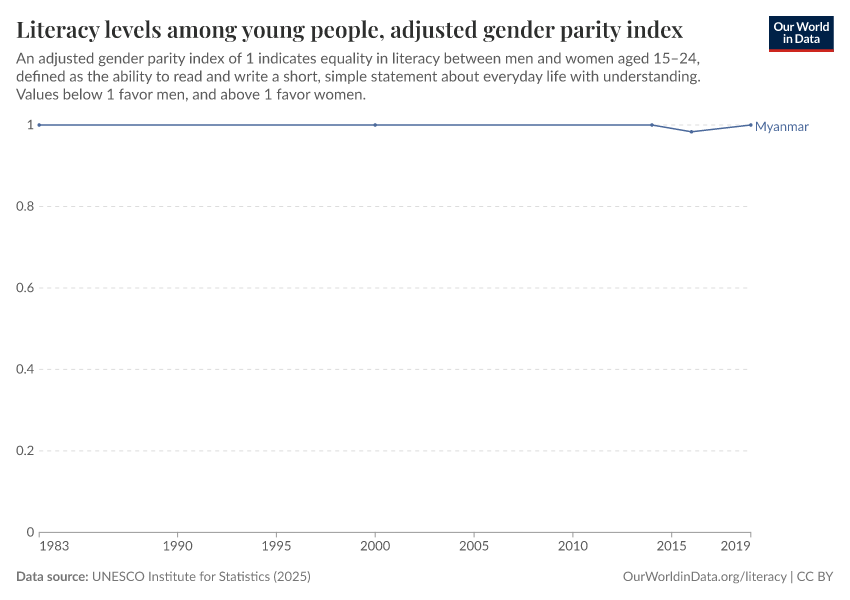Literacy levels among young people, adjusted gender parity index

What you should know about this indicator
- Literacy unlocks access to education, employment, and civic participation — this indicator shows how equally those opportunities are available to boys and girls in their youth.
- It captures gender equality in basic literacy by comparing literacy rates between young women and young men aged 15–24.
- The adjusted gender parity index (GPIA) is calculated by dividing the female youth literacy rate by the male youth literacy rate. If the result exceeds 1, it is inverted and subtracted from 2, producing a scale from 0 to 2, with 1 indicating parity.
- A GPIA value of 1 means young men and women are equally likely to be literate. A value below 1 indicates a gap in favor of males, and a value above 1 suggests a gap in favor of females.
- Literacy is usually defined as the ability to both read and write a short, simple sentence with understanding. The rate is based on self-reported data or, in some cases, assessed through basic reading or writing tasks.
- Data sources include national censuses and household surveys. The UNESCO Institute for Statistics (UIS) and partners may also use modelled estimates when recent or complete data are not available.
- This indicator measures basic literacy, not functional literacy. It reflects the presence of foundational skills, but not whether they are applied effectively in everyday contexts.
- Cross-country comparability may be affected by differences in definitions, data collection methods, and the extent to which responses are self-reported or verified.
What you should know about this indicator
- Literacy unlocks access to education, employment, and civic participation — this indicator shows how equally those opportunities are available to boys and girls in their youth.
- It captures gender equality in basic literacy by comparing literacy rates between young women and young men aged 15–24.
- The adjusted gender parity index (GPIA) is calculated by dividing the female youth literacy rate by the male youth literacy rate. If the result exceeds 1, it is inverted and subtracted from 2, producing a scale from 0 to 2, with 1 indicating parity.
- A GPIA value of 1 means young men and women are equally likely to be literate. A value below 1 indicates a gap in favor of males, and a value above 1 suggests a gap in favor of females.
- Literacy is usually defined as the ability to both read and write a short, simple sentence with understanding. The rate is based on self-reported data or, in some cases, assessed through basic reading or writing tasks.
- Data sources include national censuses and household surveys. The UNESCO Institute for Statistics (UIS) and partners may also use modelled estimates when recent or complete data are not available.
- This indicator measures basic literacy, not functional literacy. It reflects the presence of foundational skills, but not whether they are applied effectively in everyday contexts.
- Cross-country comparability may be affected by differences in definitions, data collection methods, and the extent to which responses are self-reported or verified.
Sources and processing
This data is based on the following sources
How we process data at Our World in Data
All data and visualizations on Our World in Data rely on data sourced from one or several original data providers. Preparing this original data involves several processing steps. Depending on the data, this can include standardizing country names and world region definitions, converting units, calculating derived indicators such as per capita measures, as well as adding or adapting metadata such as the name or the description given to an indicator.
At the link below you can find a detailed description of the structure of our data pipeline, including links to all the code used to prepare data across Our World in Data.
Reuse this work
- All data produced by third-party providers and made available by Our World in Data are subject to the license terms from the original providers. Our work would not be possible without the data providers we rely on, so we ask you to always cite them appropriately (see below). This is crucial to allow data providers to continue doing their work, enhancing, maintaining and updating valuable data.
- All data, visualizations, and code produced by Our World in Data are completely open access under the Creative Commons BY license. You have the permission to use, distribute, and reproduce these in any medium, provided the source and authors are credited.
Citations
How to cite this page
To cite this page overall, including any descriptions, FAQs or explanations of the data authored by Our World in Data, please use the following citation:
“Data Page: Literacy levels among young people, adjusted gender parity index”, part of the following publication: Hannah Ritchie, Veronika Samborska, Esteban Ortiz-Ospina, and Max Roser (2023) - “Global Education”. Data adapted from UNESCO Institute for Statistics. Retrieved from https://archive.ourworldindata.org/20250909-093708/grapher/ratio-of-the-literacy-rate-between-young-women-and-men.html [online resource] (archived on September 9, 2025).How to cite this data
In-line citationIf you have limited space (e.g. in data visualizations), you can use this abbreviated in-line citation:
UNESCO Institute for Statistics (2025) – with minor processing by Our World in DataFull citation
UNESCO Institute for Statistics (2025) – with minor processing by Our World in Data. “Literacy levels among young people, adjusted gender parity index” [dataset]. UNESCO Institute for Statistics, “UNESCO Institute for Statistics (UIS) - Education” [original data]. Retrieved January 15, 2026 from https://archive.ourworldindata.org/20250909-093708/grapher/ratio-of-the-literacy-rate-between-young-women-and-men.html (archived on September 9, 2025).